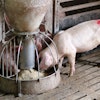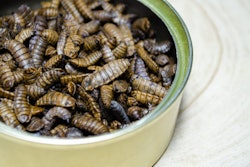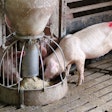
Fungal enzyme produced alongside fumonisin could detoxify contaminated animal feed
A group of Canadian scientists believe one of the fungi that produce the mycotoxin fumonisin may also produce a potential cure: an enzyme that renders the toxin harmless.
Researchers at the London Research and Development Center in Ontario had a three-year study in the works regarding wine production and the fungi Aspergillus, when they began to notice the presence of what appeared to be a new fumonisin toxin, according to Mark Sumarah, a research scientist at the London Research and Development Center. This fumonisin, however, had an oxygen molecule where a nitrogen belonged, rendering it harmless.
The initial group on the project guessed a chemical process must be involved and brought in Chris Garnham, an additional researcher at the center with particular expertise in biochemistry. On further inspection, they discovered a previously unknown enzyme apparently responsible for the transformed fumonisin. And, to their surprise, the Aspergillus producing the fumonisin also seemed to be creating the enzyme.
“Antibiotics are produced by competing organisms,” so the idea that Apergillus could create a sort of natural mycotoxin binder isn’t terribly surprising, according to Justin Renaud, a chemist with the London Research and Development Center. “What’s strange about this is the same organism is producing the poison and the antidote. One organism, for whatever reason, is producing both at the same time.”
While more work is necessary to determine whether the enzyme can be used to effectively eliminate fumonisins from animal feed, the enzyme appears to hold promise, Sumarah said. Enzymes are already used commercially to nullify fumonisins, though they don’t completely eliminate the mycotoxin or its toxicity, he said. In an initial trial using duckweed, which is highly sensitive to fumonisins, this new enzyme appeared to render the fumonisin entirely nontoxic.
The next step, Garnham said, is to see if the enzyme has a similar effect in a cell line and potentially in feed trials with live animals.
If the results hold in subsequent trials, then it should be possible to use other microorganisms to produce the enzyme at scale and add it to animal feed or other products to detoxify potential contaminants. At the London Research and Development Center, Garnham said the research group is now looking at whether yeast species used in bioethanol production could be essentially programmed to produce the enzyme, allowing them to decontaminate corn while simultaneously creating ethanol.
“There’s many different ways you could apply it,” Garnham said.
Sumarah said the research team has filed for a patent and has begun work with a partner to explore commercialization. But he noted that it could still be some time before a feed additive is available to producers given the number of hurdles that must still be cleared. He pointed to enzymes found to act on other mycotoxins that proved too costly to produce for use in commercial applications as an example.
“As a feed additive, we are hopeful,” Sumarah said, “but in order for something to get from the lab to the shelf, there are many factors — political, regulatory, and it has to make economic sense for the industry.”
















